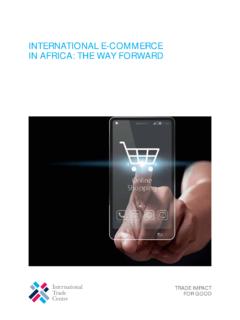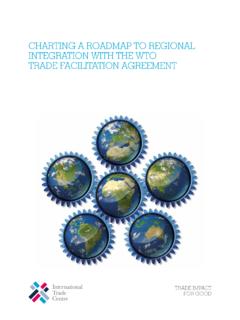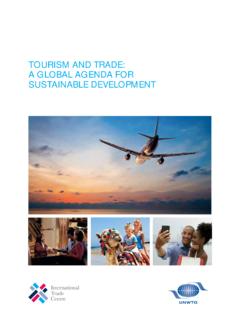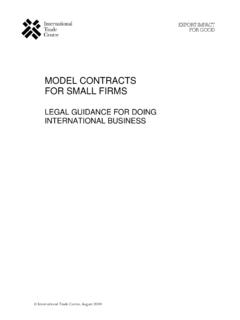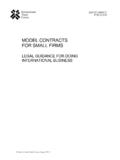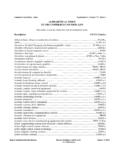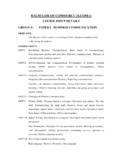Transcription of BRINGING SMES ONTO THE E-COMMERCE …
1 BRINGING smes onto . THE E-COMMERCE highway . TRADE IMPACT. FOR GOOD. Digital images on the cover: Shutterstock The designations employed and the presentation of material in this document do not imply the expression of any opinion whatsoever on the part of the International Trade Centre concerning the legal status of any country, territory, city or area or of its authorities, or concerning the delimitation of its frontiers or boundaries. This document has not formally been edited by the International Trade Centre. BRINGING smes onto . THE E-COMMERCE highway . BRINGING smes onto THE E-COMMERCE highway . Abstract for trade information services ID=43195 2016 BRI.
2 International Trade Centre (ITC). BRINGING smes onto the E-COMMERCE highway Geneva: ITC, 2016. xiii, 101 pages Doc. No. This publication studies E-COMMERCE -related policies that affect smes ' engagement in cross-border E-COMMERCE . It identifies the bottlenecks and requirements of E-COMMERCE participation and presents examples of best practices in regulating cross-border E-COMMERCE . The paper addresses competitiveness issues in each segment of the cross-border E-COMMERCE process chain, including establishing business online, international e-payment, cross-border delivery and aftersales services. It provides a checklist of the essential ingredients for SME success in cross-border E-COMMERCE , by examining enabling factors at the firm level, immediate business environment level and national policy level.
3 The paper also reviews global cross-border E-COMMERCE and offers a deeper analysis of selected economies. The paper serves as a starting point for a public private dialogue on E-COMMERCE , especially for smes in developing countries. Descriptors: Electronic commerce , Cross-border Trade, smes , Competitiveness, Public Private Dialogue For further information on this technical paper, contact Ms. Marion Jansen Citation: International Trade Centre (2016). BRINGING smes onto the E-COMMERCE highway . ITC, Geneva. English The International Trade Centre (ITC) is the joint agency of the World Trade Organization and the United Nations.
4 ITC, Palais des Nations, 1211 Geneva 10, Switzerland ( ). Digital image(s) on the cover: Shutterstock International Trade Centre 2016. ITC encourages the reprinting and translation of its publications to achieve wider dissemination. Short extracts of this technical paper may be freely reproduced, with due acknowledgement of the source. Permission should be requested for more extensive reproduction or translation. A copy of the reprinted or translated material should be sent to ITC. ii BRINGING smes onto THE E-COMMERCE highway . Foreword Transformations in the landscape of trade and technology have fundamentally altered the way we purchase and consume goods and services.
5 As the costs of international communication and transportation decrease, and the demand for immediacy increases, suppliers are increasingly turning to E-COMMERCE and e-platforms as the preferred method for reaching clients. Online shoppers are experiencing a revolution in their buying habits, often seeking options in other countries and regions. These changes can offer significant opportunities for businesses in both developed and developing countries to expand their outreach into global markets. By any measure, E-COMMERCE is big business. For example, by 2018 Africa's E-COMMERCE market is projected to soar to US$ 50 billion, up from US$ 8 billion in 2013.
6 E-COMMERCE represents a sea change in the way that trade is conducted, and offers great potential to contribute to the United Nations Global Goals. For many people, E-COMMERCE is becoming business as usual. Online retail is estimated by the Centre for Retail Research to account for 13% of consumer spending in the United States and around 10% in Europe, and much more in some countries such as the United Kingdom and Germany. And yet, many developing countries are still not taking full advantage of this opportunity. Best estimates put the current share of African enterprises in E-COMMERCE , for instance, at below 2%, a share that could be much higher.
7 Cross-border E-COMMERCE has opened up a new, more efficient way to connect producers and merchants directly to customers around the world, bridging the gap between demand and supply. It opens new opportunities by providing new markets, products and services but also by reducing the role of intermediaries, which can result in substantial purchasing discounts. Cross-border E-COMMERCE also provides a unique opportunity for small and medium-sized enterprises ( smes ) in countries and regions that may traditionally have found it difficult to reach regional and international markets such as landlocked developing countries (LLDCs) and connect with potential buyers beyond their borders.
8 This report provides practical guidance on how to ensure that the opportunities posed by E-COMMERCE are accessible to smes , especially those in developing countries. In practice, a number of barriers effectively preclude the involvement of a majority of smes . Key among them is the level of shipping costs, which can be especially high for small volumes of traffic from remote smes . Another barrier is the availability and cost of international payment solutions: In many least developed countries, for example, firms cannot open such facilities, or must rely on expensive cash transfers that are increasingly shunned by international customers.
9 Business-to-consumer (B2C) E-COMMERCE opens the possibility for producers to capture higher margins, again by disintermediation in the international distribution of goods. However, this form of trade also requires the use of postal or express delivery services that ship directly to the consumer. Failure to take taxes and duties into account can generate a high proportion of rejected shipments and have a negative impact on an SME's profitability and reputation. The high-frequency, low-value nature of B2C cross-border E-COMMERCE presents new challenges for regulators, particularly customs authorities, in handling the growing number of items traded across borders.
10 Some countries have piloted innovative trade facilitation and regulatory practices, such as simplified customs duties and clearance procedures for low-value items, which further reduce cross-border E-COMMERCE costs. This publication examines regulatory issues and key determinants for competitiveness related to cross- border E-COMMERCE from the perspective of a small e-business. Potential bottlenecks are identified and examples of best practices are provided. Each segment of the cross-border E-COMMERCE process chain, including establishing business online, international e-payment, cross-border delivery and aftersales services, is considered in detail.
